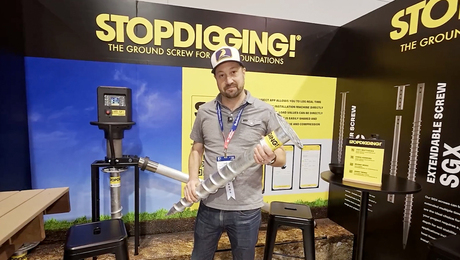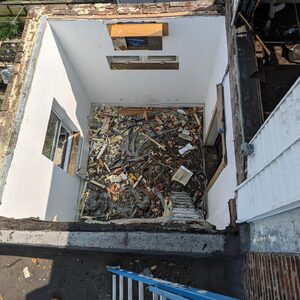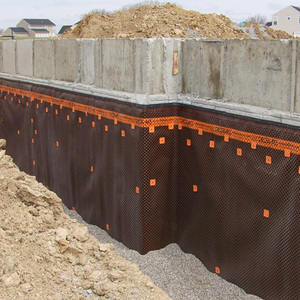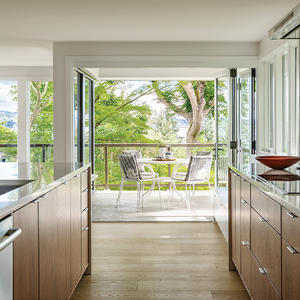Hello All,
I’m remodeling a master bathroom (my own) and was advised to use Hardibacker cementatious backer board for the walls in the shower area, but to switch to green board for the remainder of the walls and ceiling. Looking over the Hardibacker web site regarding installation, I see nothing that addresses my concerns. One, installation of hardibacker requires use of a thin set and alkali resistant fiberglass tape. OK. Fine. If i’m tiling over these surfaces that’s no problem. However, how do I prepare the thin set covered joints and screw heads (which are driven only flush with backer board as James Hardie advices) for primer and paint??? The surface of the Hardibacker looks too “coarse” for a smooth application of paint. Two, where gypsum wallboard meets Hardibacker, how does one address the resulting joint? Joint compound or thinset?? Lastly, would I save myself headaches by applying Hardiebacker for the entire job. The space is minimal, 8 ft ceilings and a 4 ft by 10 ft area.
Thanks!



















Replies
You understand that Hardibacker is an underlayment or substrate for tile and not a wall board product like sheetrock, right?
I'm interested to see exactly what he means, but it does seem like he's not tiling the surround.
but there's nothing wrong with using HardiBacker as your finished wallboard. In older homes with plaster walls I prefer using Hardibacker to make smaller repairs. Much more solid than DW, takes less work to match the plaster's texture, and it feels and sounds more like the original plaster. Not that normal people actually notice that, but...
I've also wondered about taking it a step further maybe doing a hallway or room with HB, horizontal joints could be covered with chair rail at 60'', and up higher a picture rail or frieze if you have tall ceilings. Wall frames from floor to ceiling could take care of the vertical joints. Not normal, and expensive to trim that way, but these are the things I think about.
HB is also great for shower ceilings if you can use one piece, which you usually can.
Don't get me wrong, I still hate cutting the stuff.
Yeah, I guess it's possible Mike. He could probably also get decent results using $20 bill for insulation... know what I mean? Just cuz you can doesn't always mean you should.
Maybe I mis-read, but I'm not even 100% sure he's talking about tiling over it in the shower area. He seems to want to know how to prime and paint over the seams and screw heads.... maybe I'm jaded, but that sends a red flag up from where I'm sitting. Just trying to get the facts straight. Maybe he's got it all under control.View Image
My idea does ring of insanity, diesel. Won't argue there.
That's just what happens when I start thinking.
I can relate. I'm just worried that this guy is gonna hang Hardi on the studs in his shower, paint it, and call it a day. I guess the good news would be that it won't take long to figure out that it's a mistake. :)
Maybe I'm reading into it too much and he just worded his question in an odd way. Hope he comes back and clears it up though.View Image
Hey Diesel.......you read correctly.
Maybe he should use "durock" and stucco over it with "venetian plaster"sp? before painting.
And don't forget to remind the framer..... 18" OC please. :)View Image
Sh!t....the framing's done already........no ssweat.....he could just trim all the HB boards to 32" wide....the trim will cover the rough edges.
No - it is smart. Try it on a small bathroom. Will never crumble or rot from moisture. I did it on my house and it looks and works great. Used smooth back of hardiboard
horizontal joints could be covered with chair rail at 60''
you'all sure have tall chairs in FL.
I agree that hardibacker would do nicely for patches...but....to use it on a hall or a room....then cover all the vert and horiz seams (for these little 3X5 sheets) with trim????????
You must own quite a bit of hardibacker stock to push it that hard.
I guess you could go with a 36'' chair rail, running the bottom course of HB fat, and the top course skinny. But now I'm gonna have to totally redesign everything. That 60'' rail in my HardiHall was gonna clash with my foot-operated light switches anyway.
Gentleman,
Thanks so much for your response. Sorry that my description of my Hardibacker concerns was not the easiest to grasp or understand. In the interest of clarification, I'm tiling completely in the shower space (defined at the base by a Kohler receptor), and tiling up to approximately 48" (wainscotting?) outside the shower area. With the assistance you provided I now can shake off this bit of a bump in progress and wallboard and HB away. You guys are great!
Ciao!
Geoman
and for what it's worth ...
should U install the backer where the tile layout dictates ... and line them joints up so they'll all be nice and hidden by the border tiles ....
and then the designer changes everything and U are left with big swatches of now exposed backer ...
U can very nicely feather it smooth with a setting joint compound ... like Durobond or my favorite Easysand ... coupla light coats ... and it'll paint up just fine.
and ... I don't like greenboard anywhere. I use regular drywall everywhere the hardi ain't. Use a good bath paint ... like PermaWhite. Plus ... for ceilings ... U gotta increase the framing ... they recommend joists at 12 inches on center.
Use regular drywall and U can use the standard 16oc.
Jeff Buck Construction
Artistry In Carpentry
Pittsburgh Pa
What Jeff said, except maybe use DensArmor and maybe use DensShield for the non-shower tile area. A setting joint compound smoothes out nicely.
What, you guys can't get the 4x8 PermaBase where you're at? Eh, I don't even know off hand if you can use that stuff for walls.
And...JeffBuck is right, beef up the ceiling if you're going with anything more than drywall in there.
And about DensArmor, do yourself a favor if you go there and wear your Teflon suit. Itchy, itchy, and more itchy.
The hardi to greenboard joint should be clear of the area where it would be subject to regular contact with water. For example, the tile should end outside of where the shower curtain or glass door will be.
A transition type tile (with a finished edge, like a bull nose or edge tile) can bridge the transition from hardi and thinset to the drywall.
Your mileage may vary, but - ideally - the thickness of the hardi and thinset should be pretty close to the thickness of the 1/2 green board. The tranisition tile will be set in thinset, but part of the tile will bridge onto the greenboard. You could run a bead of silicone on the back of the tile that lands on the greenboard.
Tape along the "greenboard" edge of the transition tiles before you grout. Pull the tape when done, re-tape an 1/8" away from the edge on both sides and then caulk the joint.
Adventures in Home Building
An online journal covering the preparation and construction of our new home.
The hardiebacker sheets for tub/shower are sized to go five feet above the tub, and it takes four of these installed vertically for a typical surround.
Use these, and plan for your tiles to extend just past the border where the greenboard starts. you can use fiberglass tape with thinset to span the gap, but you may want to use some joint compound to have a smooth transition coming out from under the edge.
In other words, the room can be rocked, taped and finished with a good oil based paint before you tile. When you spread your thinset to attach the bullnose border tiles, mask the walls so that the very edges will stay clean (no thinset), and caulk the resulting gap under the tiles.
A word of advice: before you hang the backer, make sure your framing is as plumb and square as possible. This is your chance to correct problems so that the tiles will go on evenly with no funky cutting. And whatever else you do - take extra care to protect your tub or shower pan from scratching. EDIT: in other words, "what HE said!"
Edited 7/12/2006 2:37 pm ET by saulgood
If i'm tiling over these surfaces that's no problem. However, how do I prepare the thin set covered joints and screw heads (which are driven only flush with backer board as James Hardie advices) for primer and paint??? The surface of the Hardibacker looks too "coarse" for a smooth application of paint.
What shade of blue "rubberized pool paint" are you using on the hardibacker in your shower?
Why not tiles or some other more water proff material/finish?????
I used the smooth back of hardy backer in the entire bathroom- taped with fiberglass and smooth cement. Sealed it. Finished with a high quality vinlyl patching compound. Looks smooth like sheetrock but it will never crumble from moisture.
To me - installing sheetrock or greenboard in a bathroom is more insane. It cant get wet.
5 years in and backer board wall look perfect